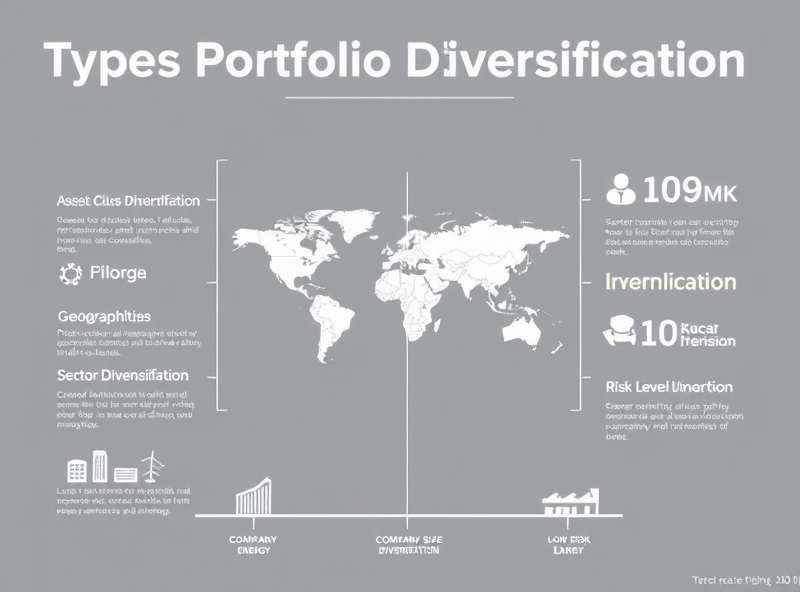
Portfolio Diversification: Strategies for Risk and Returns
Types of Portfolio Diversification

Portfolio diversification is a key strategy for reducing risk and maximizing returns in your investments. But did you know there are different types of diversification you can apply to your portfolio? Understanding these types can help you make more informed decisions and achieve a balanced investment strategy. Here are the main types of portfolio diversification:
1. **Asset Class Diversification**: This involves spreading your investments across different asset classes such as stocks, bonds, real estate, and commodities. Each asset class reacts differently to market conditions, so diversifying among them can help stabilize your portfolio.
2. **Geographical Diversification**: Investing in markets across different countries or regions can reduce the risk associated with economic or political instability in a single area. For example, combining investments in both developed and emerging markets can offer a balance of stability and growth potential.
3. **Sector Diversification**: Within the stock market, you can diversify by investing in various industries or sectors, such as technology, healthcare, finance, and energy. This ensures that a downturn in one sector doesn’t overly impact your entire portfolio.
4. **Company Size Diversification**: Balancing investments between large-cap, mid-cap, and small-cap companies can help you benefit from the stability of larger firms and the growth potential of smaller ones.
5. **Risk Level Diversification**: Not all investments carry the same level of risk. Combining high-risk, high-reward investments with low-risk, stable options can help you align your portfolio with your risk tolerance and financial goals.
By diversifying your portfolio across these dimensions, you can reduce the impact of market volatility and create a more resilient investment strategy. Remember, the goal is not just to spread your investments randomly but to create a thoughtful balance that aligns with your financial objectives.
Risk Management Techniques for Investors

Managing risk is a crucial part of successful investing. By understanding and applying effective risk management techniques, investors can protect their portfolios from significant losses while maximizing potential returns. Here are some key strategies to consider:
1. **Diversification**: One of the most effective ways to manage risk is by diversifying your portfolio. This means spreading your investments across different asset classes, industries, and geographic regions. By doing so, you reduce the impact of a poor-performing investment on your overall portfolio.
2. **Asset Allocation**: Properly allocating your assets based on your risk tolerance, financial goals, and investment horizon is essential. For example, younger investors might allocate more to equities for growth, while older investors may prefer bonds for stability.
3. **Regular Portfolio Rebalancing**: Over time, your portfolio may drift from its original allocation due to market fluctuations. Regularly rebalancing ensures that your portfolio stays aligned with your risk tolerance and investment goals.
4. **Stop-Loss Orders**: A stop-loss order automatically sells a security when it reaches a certain price, helping to limit potential losses. This is particularly useful for volatile stocks.
5. **Emergency Fund**: Before investing, ensure you have an emergency fund to cover unexpected expenses. This prevents you from having to sell investments at a loss during financial emergencies.
6. **Stay Informed**: Keep up with market trends, economic news, and changes in the industries you’re invested in. Being informed allows you to make proactive adjustments to your portfolio.
By implementing these techniques, you can navigate the uncertainties of the market with greater confidence and achieve your long-term financial goals. Remember, risk is an inherent part of investing, but with the right strategies, it can be managed effectively.
Maximizing Returns Through Diversification

Diversification is a cornerstone of successful investing, and it’s all about spreading your investments across various asset classes to balance risk and reward. By not putting all your eggs in one basket, you reduce the impact of a poor-performing asset on your overall portfolio. For example, combining stocks, bonds, real estate, and even alternative investments like commodities or cryptocurrencies can help you achieve a more stable return over time.
The key to maximizing returns through diversification lies in understanding the correlation between assets. Assets that don’t move in the same direction during market fluctuations can help cushion your portfolio against losses. For instance, when stocks are down, bonds or gold might perform better, balancing out the overall impact. Additionally, geographic diversification—investing in both domestic and international markets—can protect your portfolio from region-specific economic downturns.
Remember, diversification doesn’t guarantee profits or protect against all losses, but it’s a proven strategy to manage risk and optimize returns over the long term. Regularly reviewing and rebalancing your portfolio ensures that your asset allocation aligns with your financial goals and risk tolerance. Start small, stay consistent, and watch your investments grow steadily.
Practical Framework for Diversified Portfolios

Building a diversified portfolio is one of the most effective ways to manage risk while optimizing returns. Diversification involves spreading your investments across various asset classes, industries, and geographic regions to reduce the impact of a poor-performing investment. A practical framework for diversification starts with understanding your financial goals, risk tolerance, and investment timeline.
First, allocate your assets across different categories such as stocks, bonds, real estate, and cash. For example, stocks can offer higher returns but come with higher risk, while bonds provide stability and steady income. Including real estate or REITs (Real Estate Investment Trusts) can add a layer of diversification tied to physical assets.
Second, diversify within each asset class. For instance, if you’re investing in stocks, consider spreading your investments across different sectors like technology, healthcare, and consumer goods. Additionally, look at geographic diversification by investing in both domestic and international markets. This helps mitigate risks associated with economic downturns in a specific region.
Lastly, regularly review and rebalance your portfolio. Market conditions and your financial goals may change over time, so it’s important to adjust your allocations to stay aligned with your objectives. Remember, diversification doesn’t eliminate risk entirely, but it can significantly reduce it, giving you a more stable path toward achieving your financial goals.




